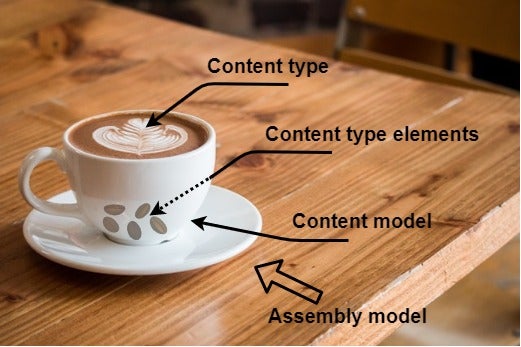What’s content modeling?
If the content were coffee, the content model would be the coffee cup, which holds all ingredients and the final product together. Find out what other parts of a content model represent compared to coffee, along with examples from other areas, and what purpose it has in your content production.
Caffeinated content modeling
As mentioned, when you imagine content as coffee, the content model would be the coffee cup. The cup is a constraint, but with the ingredients, it also gives you a lot of possibilities when making coffee. Content modeling is very similar to this real-world scenario. In content modeling, ingredients would be your content type elements. The same ingredients can be used to make different types of coffee, so you are also able to create different content types with your content type elements. Overall, the process of preparation would be the assembly model. You don’t need to remember this term, but it can be a suitable keyword if you look for more content modeling information.
Examples from other worlds
Here are some other examples you can use to understand different content modeling terms:| Content | Article | Coffee | Building | Information |
| Assembly model | Order of sections | Steps | Building blueprint | SQL |
| Content model | Structure of articles and how they relate to each other | Coffee cup | Building codes | Database |
| Content types | Blog, News, Breaking news | Flat white, Cappuccino, Cafe latte, Lungo, Cold brew | Bungalow, Duplex, Villa | Table |
| Content type elements | Images, Text, Video | Water, Beans, Milk, Creamer, Sugar | Mortar, Bricks, Water, Cement, Timber, Tiles | Column |
| Content chunks | SEO fields, Metadata fields, CTAs | Coffee pods, Creamer, Nescafe 3-in-1 | Pre-fab walls, Windows, Doors | Variable |
A content model’s purpose
Detailed and careful preparation, with great ingredients and a bit of uniqueness, will set you up for success if you plan to open your own coffee chain. The same can be said for the content model.The content model is the foundation of your project, and although it may have similarities with the content models of others, it will have some unique traits. It’s so unique that no one will have exactly the same content model as you or your company. It’s only yours and no one else’s.Creating a good model is hard, so the best approach is to start small and iterate. This can be done by building it in a flexible and extensible way. This should be your mantra for the whole process. On top of that, involve at least one stakeholder per department to address their needs and get internal buy-in for the model.